Technical Information
techquestions@techno-isel.com
11
Thrust
TRANSLATION
(OR LINEAR)
JOURNAL
OR RADIAL
BEARING
Bearing
surface
THRUST
BEARING
Radial
Load
ROTATION
Motion
Motion
Load
Load
PLAIN BEARING
Bearing
Journal
4) Load Bearing Mechanisms
Load bearing mechanisms are the structural backbone of any linear/rotary motion system, and are a critical
consideration. This section will introduce most of the more common types of load bearing mechanisms
found in linear motion machinery. In general, bearings allow smooth, low friction motion between two surfaces
loaded against each other. The motion can be either rotary (such as in a turning shaft) or linear (such as a
machine part moving back and forth). Some applications require that a bearing accommodate both types of
motion simultaneously, which is referred to as a combination bearing. In both cases there should be a
strong attempt to provide enough lubrication to keep the bearing surfaces separated by a film of oil. The
absence of physical contact provides most bearings with long service lives.
Bearings are evaluated on the basis of how much load they carry, at what speeds they can carry the load,
and how long they will serve under those conditions. Friction, start-up torque, shock- and impact-resistance,
operating environment, rigidity, size, cost, complexity, and lubricating procedures are also important design
considerations.
The following diagram reveals the basic bearing families more widely found in linear motion systems. The
distinction between families is made by the type of motion and type of loading being considered. Bearings
accommodate rotational and/or translational motion. Translational bearings, or linear bearings, are loaded
perpendicular (radial) to the direction of motion. Rotational bearings can be loaded either perpendicular to
the axis of rotation (radial) or parallel to the axis of rotation (thrust).
Most bearings can be classified into one of two general types. The distinction between bearing types is
made by the nature of the bearing mechanism. The two types each have a number of different possible
configurations, and some of the more common configurations will now be discussed. Since many bearings
are either specialized or of proprietary design, this discussion is by no means intended to be all exhaustive,
but rather to serve as an introduction.
Plain Bearings, or Journal Bearings, are the most basic type of bearing.
They have no moving parts, they support loads through sliding contact,
and are usually the least costly to install. Some plain bearings are self-
lubricating and maintenance-free while others are not. In fact, some
plain bearings are classified as to the lubricating method required.
Typically, plain bearings will operate right up to the point of failure with
little or no warning signs. Since the motion involved is usually low level,
the results of failure are typically noncatastrophic, and replacement or
repair is fairly simple. There are several ways to size plain bearings for
an application, as outlined at the end of this section.

